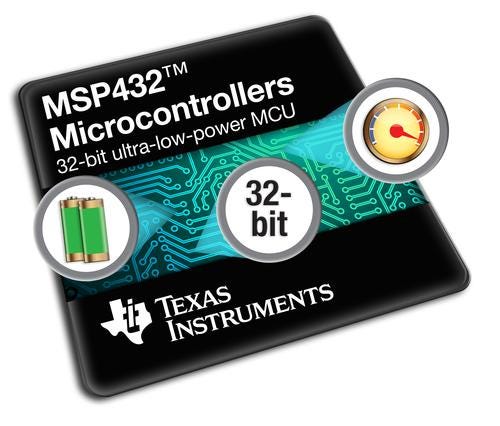TI Boosts Performance of Ultra-Low Power MCUs
March 24, 2015

Texas Instruments will make one of its biggest microcontroller (MCU) announcements in years today, as it rolls out an ultra-low-power platform aimed at sensor hubs and portable applications.
Known as the MSP432, the new platform is said to be the "world's lowest power Cortex-M MCU." It could be especially important for industrial applications involving multiple sensors because it provides the performance to handle large streams of data without compromising power requirements. "In the past, there have been tradeoffs," Mione Plant, product marketing engineer for Texas Instruments, told Design News. "In a typical case, adding performance would have affected power. The biggest advantage of this new platform is that it eliminates those big tradeoffs."

An extension of TI's existing MSP430 platform, the new family of devices is the first from that platform to graduate to a 32-bit ARM-based architecture. The 32-bit core offers 48-MHz performance, compared to 25 MHz for the 16-bit MSP430 devices. At the same time, it consumes only about 95 muA/MHz in active power and 850 nA in standby power.
TI said the new devices will also be a good fit for wearable applications that have no room for big batteries. Pedometers, for example, may now be endowed with sufficient processing capability to more easily handle optical heart rate monitoring and GPS tracking. "This allows them to still be worn around your wrist or elsewhere on your body without the need for big, klunky batteries," Plant told us.
MORE FROM DESIGN NEWS: 25-Cent, 16-Bit MCUs Add Punch to Low End of MCU Market</>
The announcement is consistent with the electronics industry's ongoing move toward lower power. Whereas, chip suppliers talked mostly about the price-performance curve a decade ago, power in most cases has become equally important. "If you go back a few years, you didn't have as many portable applications," Tony Massimini, chief of technology for Semico Research, told us. "Now, though, more and more attention is being focused on power, not only for portable applications, but for non-portable applications, as a way of keeping system cost down." At lower current draws, he added, developers are often able to eliminate a cooling fan from non-portable designs.
At the same time, many portable products need low power more than searing performance, Massimini said. "For a lot of microcontroller applications, you don't need a gigahertz," he told us. "Lower power is sometimes more of a selling point, especially in those portable applications."
MORE FROM DESIGN NEWS: 30 Seconds With Texas Instruments</>
Using a parameter known as the ULP Bench Score, which reportedly offers a real-world measure of power and performance, TI said the MSP432 outperforms all other Cortex-M MCUs on the market. The new device's ULP is 167.4, which is said to be about 20% better than any other existing MCUs.
TI said the new platform will give developers more freedom as they seek to optimize their designs. "We're hearing from customers that they want more performance," Plant said. "The innovation here is that we balance that performance with low power."
Senior technical editor Chuck Murray has been writing about technology for 31 years. He joined Design News in 1987, and has covered electronics, automation, fluid power, and autos.
About the Author(s)
You May Also Like



